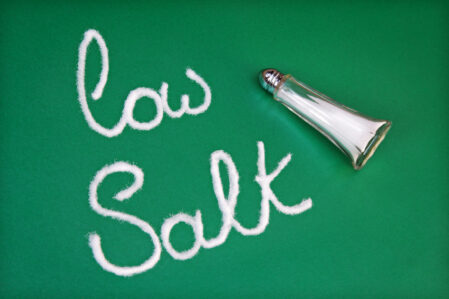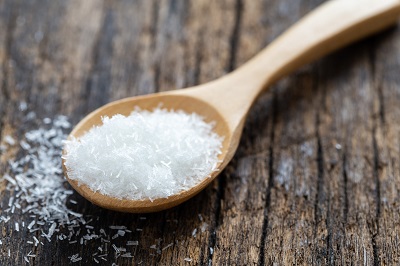
I’ve often heard the phrase “take something with a grain of salt.” The Cambridge dictionary says its meaning is “to understand that something is likely to be untrue or incorrect.”
Should you “take something with a grain of salt” when it comes to the salt used to season food? What about some of the mistaken beliefs regarding monosodium glutamate (MSG)? Yes – you should take those with a grain of salt!
Here are a few incorrect notions:
- Incorrect: Sodium and salt are the same thing.
The words “salt” and “sodium” are often used interchangeably. Technically, table salt is a chemical compound known as sodium chloride (NaCl), which consists of about 40% sodium and 60% chloride. In other words, for 1 gram of table salt, there is 0.4 gram = 400mg = of sodium.
- Incorrect: Sea salt has lower sodium content by weight than table salt, and therefore is a healthier alternative.
Sea salt has boomed in popularity, but it isn’t any less “salty.” Just like table salt, it typically contains around 40 percent sodium. However, sea salt is often found in the shape of big crystals (coarse salt), so, in turn, it is more loosely packed than table salt. A teaspoon of coarse sea salt may weigh less than a teaspoon of table salt and, therefore, may contain less sodium.
- Incorrect: Gourmet salts are a better choice than “regular” salt.
Pushing your shopping cart through the seasonings aisle of the grocery store, you’ll see more and more pretty (and pricey) bottles of “artisan” salts. (Examples are Himalayan pink salt, fleur de sel, smoked salt, and Hawaiian salt). Some companies make health claims for these specialty salts, asserting that they are purer or that they contain other healthful minerals. The truth is though the taste and aesthetic appearance may be different, our bodies can’t tell the difference. And none of these specialty salts contribute any significant minerals (other than sodium) to your diet. The same holds true for seasoned salts, like onion salt, garlic salt, or celery salt.
- Incorrect: Salt is bad for your health and you shouldn’t eat any of it.
 Your body uses sodium to balance fluids in the blood and maintain healthy blood pressure, and it is also vital for nerve and muscle function. It’s impossible to live a life without any sodium (you’d die!), but this isn’t a problem for most Americans who consume about double the recommended amount of sodium on a daily basis.
Your body uses sodium to balance fluids in the blood and maintain healthy blood pressure, and it is also vital for nerve and muscle function. It’s impossible to live a life without any sodium (you’d die!), but this isn’t a problem for most Americans who consume about double the recommended amount of sodium on a daily basis.
Reduce salt, don’t eliminate salt in your diet. Eating too much salt can contribute to high blood pressure, which is linked to conditions like heart disease and stroke, kidney problems, fluid retention, and osteoporosis. You might think this should mean you need to cut out salt completely, but salt is actually an essential nutrient for the human body.
- Incorrect: Food with less salt tastes bland.
You can get delicious food using less salt. Adding other ingredients like herbs and spices, wine, onions, chilies and lemons to recipes can boost flavor.
Scientific studies show that you can use MSG to enhance the flavor of foods without adding as much sodium (compared with seasoning only with salt). MSG is the sodium salt of glutamic acid (glutamate), an amino acid which occurs naturally in protein-containing foods such as meat, vegetables and dairy products. The savory qualities of the glutamate in MSG add flavor to food without creating a taste of overwhelming saltiness.
- Incorrect: MSG is a salt substitute.
There are many salt substitutes, the most common replacing some or all of the sodium with potassium (potassium chloride). Most people can use them, but certain medical conditions (like kidney disease) and medications can have an impact on your potassium intake. And a downside is that potassium chloride tastes bitter, or metallic, to some people.
MSG is not a salt substitute per se, but it is a safe substitute for salt when you want less sodium. Since MSG still contains some sodium, think of it as an ingredient to lower salt (to eat less salt) – but not as a salt substitute.
- Incorrect: MSG is high in sodium.
MSG contains two-thirds less sodium than table salt. MSG contains about 12% sodium while table salt contains 39% sodium (per the USDA nutrient database). Moreover, MSG represents a minor contribution to the overall sodium level of a typical diet. Considering all sources of dietary sodium (natural sodium content of foods, table salt, sodium-containing ingredients in processed foods, drinking water and pharmaceuticals), typical use of MSG contributes about 1 to 2 percent of the total sodium contained in the average daily American diet.
- Incorrect: A grain of salt is a lot of sodium.
According to the Encyclopedia Britannica, a grain is a unit of weight equal to 0.065 grams. For reference, 6 grams = 1 teaspoon. So a typical grain of salt is 1/100 of a teaspoon. Not much salt – or sodium – at all!
- Incorrect: Take MSG with a grain of salt.
MSG can be a helpful ingredient for people on a reduced sodium diet, because it improves the flavor of a dish while reducing the need for salt.
Read more on this topic:


